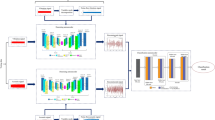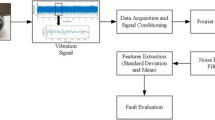Abstract
This paper proposes a highly reliable multi-fault diagnosis scheme for low-speed rolling element bearings using an effective time–frequency envelope analysis and a Bayesian inference based one-against-all support vector machines (probabilistic-OAASVM) classifier. The proposed method first performs a wavelet packet transform based envelope analysis on an acoustic emission signal to select sub-bands of the signal that contain the most intrinsic and pertinent information about the defects. Frequency- and time-domain fault features are extracted only from selected sub-bands for fault classification. Traditional one-against-all SVMs (OAASVM), a widely used multi-class pattern recognition technique, employ an arbitrary combination of a series of binary classifiers yielding overlapped feature spaces, where a data sample can be unclassifiable. To address this limitation, we formulate the feature space of OAASVM as an appropriate Gaussian process prior (GPP) and interpret OAASVM results as a posterior probability estimation procedure using Bayesian inference under this GPP. The efficacy of the proposed probabilistic-OAASVM classifier is verified for low-speed rolling element bearings under various conditions. Experimental results indicate that the proposed method outperforms the state-of-the-art algorithms for multi-fault classification of low-speed bearings, yielding a 4.95–20.67% improvement in the average classification accuracy.
















Similar content being viewed by others
References
Abe S (2015) Fuzzy support vector machines for multilabel classification. Pattern Recognit 48:2110–2117. doi:10.1016/j.patcog.2015.01.009
Aydin I, Karakose M, Akin E (2011) A multi-objective artificial immune algorithm for parameter optimization in support vector machine. Appl Soft Comput 11:120–129. doi:10.1016/j.asoc.2009.11.003
Chakrabartty S, Cauwenberghs G (2007) Support vector machine: quadratic entropy based robust multi-class probability regression. J Mach Learn Res 8:813–839
Chen X, Zhou J, Xiao J, Zhang X, Xiao H, Zhu W, Fu W (2014) Fault diagnosis based on dependent feature vector and probability neural network for rolling element bearings. Appl Math Comput 247:835–847. doi:10.1016/j.amc.2014.09.062
Chih-Wei H, Chih-Jen L (2002) A comparison of methods for multiclass support vector machines. IEEE Trans Neural Networks 13:415–425. doi:10.1109/72.991427
de Bessa IV, Palhares RM, D’Angelo MFSV, Chaves Filho JE (2016) Data-driven fault detection and isolation scheme for a wind turbine benchmark. Renew Energy 87(Part 1):634–645. doi:10.1016/j.renene.2015.10.061
Dong G, Chen J, Zhao F (2015) A frequency-shifted bispectrum for rolling element bearing diagnosis. J Sound Vib, 339:396–418. doi:10.1016/j.jsv.2014.11.015
Finogeev AG, Parygin DS, Finogeev AA (2017) The convergence computing model for big sensor data mining and knowledge discovery. Hum Centr Comput Inf Sci 7:11. doi:10.1186/s13673-017-0092-7
Hamadache M, Lee D, Veluvolu KC (2015) Rotor speed-based bearing fault diagnosis (RSB-BFD) under variable speed and constant load. IEEE Trans Ind Electron 62:6486–6495. doi:10.1109/TIE.2015.2416673
He Y, Zhang X (2012) Approximate entropy analysis of the acoustic emission from defects in rolling element bearings. J Vib Acoust 134:061012–061012. doi:10.1115/1.4007240
Hyun-Chul K, Ghahramani Z (2006) Bayesian Gaussian process classification with the EM-EP algorithm. IEEE Trans Pattern Anal Mach Intell 28:1948–1959. doi:10.1109/TPAMI.2006.238
Islam MMM, Khan SA, Kim J-M (2015) Multi-fault diagnosis of roller bearings using support vector machines with an improved decision strategy. In: Huang D-S, Han K (eds) Advanced intelligent computing theories and applications: 11th international conference, ICIC 2015, Fuzhou, China, August 20–23, 2015. Proceedings, Part III. Springer International Publishing, Cham, pp 538–550. doi:10.1007/978-3-319-22053-6_57
Islam MMM, Khan SA, Kim J-M (2017) Reliable bearing fault diagnosis using Bayesian inference-based multi-class support vector machines. J Acoust Soc Am 141:EL89–EL95. doi:10.1121/1.4976038
Jeong I-K, Kang M, Kim J, Kim J-M, Ha J-M, Choi B-K (2015) Enhanced DET-based fault signature analysis for reliable diagnosis of single and multiple-combined bearing defects. Shock Vib 2015:10. doi:10.1155/2015/814650
Kandukuri ST, Klausen A, Karimi HR, Robbersmyr KG (2016) A review of diagnostics and prognostics of low-speed machinery towards wind turbine farm-level health management. Renew Sustain Energy Rev 53:697–708. doi:10.1016/j.rser.2015.08.061
Kang M, Kim J, Choi B-K, Kim J-M (2015a) Envelope analysis with a genetic algorithm-based adaptive filter bank for bearing fault detection. J Acoust Soc Am 138:EL65–EL70. doi:10.1121/1.4922767
Kang M, Kim J, Wills LM, Kim JM (2015b) Time-varying and multiresolution envelope analysis and discriminative feature analysis for bearing fault diagnosis. IEEE Trans Ind Electron 62:7749–7761. doi:10.1109/TIE.2015.2460242
Kang M, Islam MR, Kim J, Kim JM, Pecht M (2016) A hybrid feature selection scheme for reducing diagnostic performance deterioration caused by outliers in data-driven diagnostics. IEEE Trans Ind Electron 63:3299–3310. doi:10.1109/TIE.2016.2527623
Khoobjou E, Mazinan AH (2017) On hybrid intelligence-based control approach with its application to flexible robot system. Hum Centr Comput Inf Sci 7:5. doi:10.1186/s13673-017-0086-5
Lalani S, Doye D (2017) Discrete wavelet transform and a singular value decomposition technique for watermarking based on an adaptive fuzzy inference system. J Inf Process Syst 13:340–347
Li R, He D (2012) Rotational machine health monitoring and fault detection using EMD-based acoustic emission feature quantification. IEEE Trans Instrum Meas 61:990–1001. doi:10.1109/TIM.2011.2179819
Murphy KP (2012) Machine learning: a probabilistic perspective. MIT, Cambridge, pp 290–295
Nasiri JA, Moghadam Charkari N, Jalili S (2015) Least squares twin multi-class classification support vector machine. Pattern Recognit, 48:984–992. doi:10.1016/j.patcog.2014.09.020
Rasmussen CE, Williams C (2006) Relationships between GPs and other models. MIT, Cambridge. http://www.gaussianprocess.org/gpml/chapters/RW6.pdf
Skolidis G, Sanguinetti G (2011) Bayesian multitask classification with Gaussian process priors. IEEE Trans Neural Netw 22:2011–2021. doi:10.1109/TNN.2011.2168568
Smola AJ, Schölkopf B, Müller K-R (1998) The connection between regularization operators and support vector kernels. Neural Netw 11:637–649. doi:10.1016/S0893-6080(98)00032-X
Sollich P (2000) Probabilistic methods for support vector machines. In: Advances in neural information processing systems, MIT Press, pp 349–355
Wang D, Tse PW, Tsui KL (2013) An enhanced Kurtogram method for fault diagnosis of rolling element bearings. Mech Syst Sig Process 35:176–199. doi:10.1016/j.ymssp.2012.10.003
Yala N, Fergani B, Fleury A (2017) Towards improving feature extraction and classification for activity recognition on streaming data. J Ambient Intell Hum Comput 8:177–189. doi:10.1007/s12652-016-0412-1
Acknowledgements
This work was supported by the Korea Institute of Energy Technology Evaluation and Planning (KETEP) and the Ministry of Trade, Industry & Energy (MOTIE) of the Republic of Korea (No. 20162220100050, No. 20161120100350, and No. 20172510102130). It was also funded in part by The Leading Human Resource Training Program of Regional Neo industry through the National Research Foundation of Korea (NRF) funded by the Ministry of Science, ICT and future Planning (NRF-2016H1D5A1910564), and in part by the Basic Science Research Program through the National Research Foundation of Korea (NRF) funded by the Ministry of Education (2016R1D1A3B03931927).
Author information
Authors and Affiliations
Corresponding author
Rights and permissions
About this article
Cite this article
Islam, M.M.M., Kim, JM. Time–frequency envelope analysis-based sub-band selection and probabilistic support vector machines for multi-fault diagnosis of low-speed bearings. J Ambient Intell Human Comput 15, 1527–1542 (2024). https://doi.org/10.1007/s12652-017-0585-2
Received:
Accepted:
Published:
Issue Date:
DOI: https://doi.org/10.1007/s12652-017-0585-2




